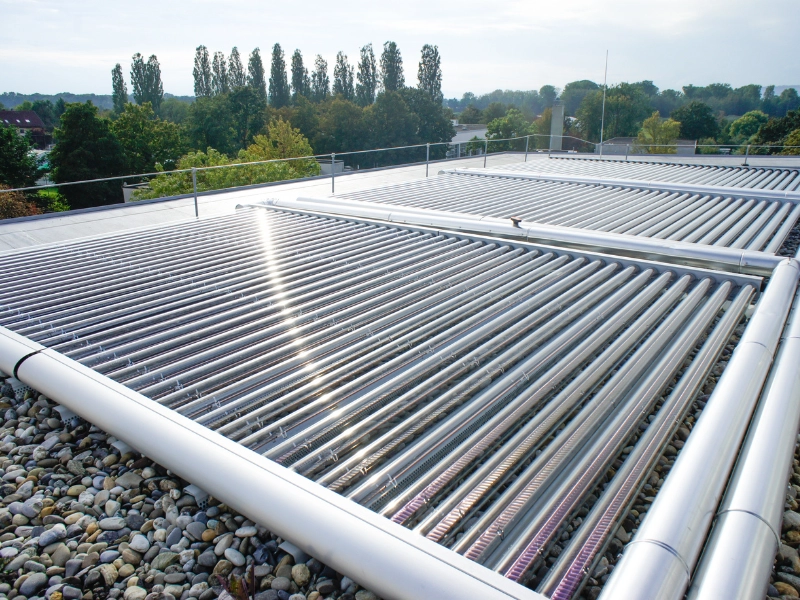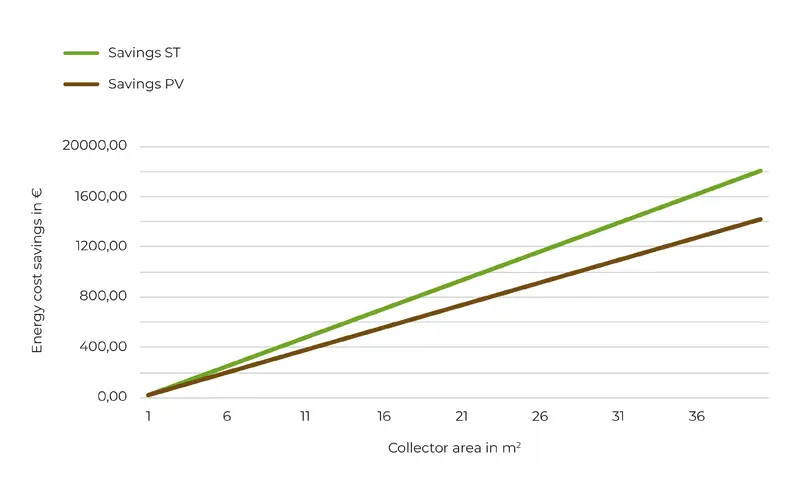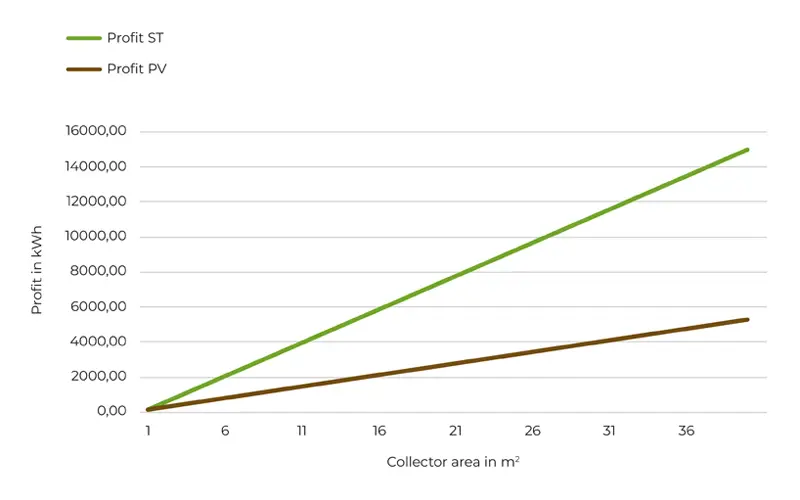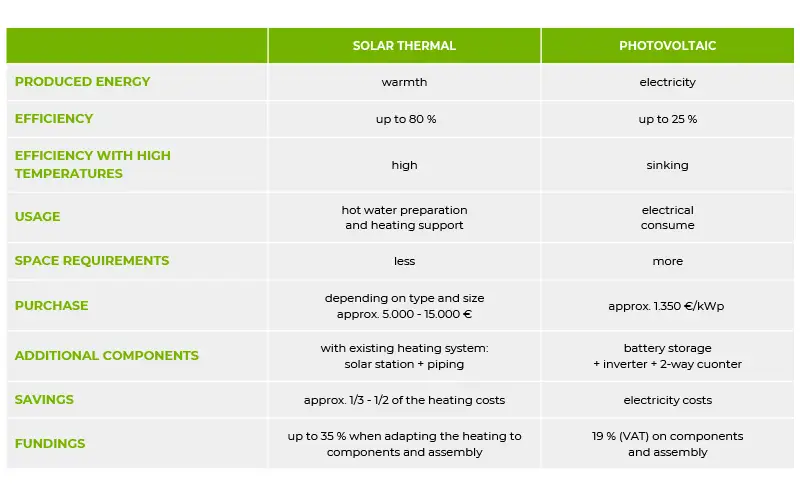-
-
Service & Garantien
Service & Garantien

Last updated on June 19, 2025
The reason for the larger surface area efficiency and cost-effectiveness of solar thermal energy lies in two main factors. First, its efficiency is significantly higher than that of photovoltaics. Second, the demand for thermal energy—and therefore the potential for self-consumption—is considerably greater.
In contrast, photovoltaics often require expensive battery storage systems to achieve high self-consumption. Additionally, post-heating with electric energy is extremely cost-efficient.*


Photovoltaics (PV) generate electricity, which can be used in many ways. In contrast, the heat produced by solar thermal systems is more specifically used within the household. However, heat demand accounts for around 85% of total household energy consumption—far exceeding the need for electricity. Approximately 13% is used for hot water, 72% for space heating, and only 15% for electrical energy.
This means that the savings potential with solar thermal energy is significantly higher, simply because there is more energy to save.*
The cost-effectiveness of a solar system depends not only on its performance but also on the total investment. For example, an AKOTEC solar thermal system including installation costs approximately €11,000, whereas a comparable photovoltaic system with battery storage costs around €19,500. In both cases, 50% of the total cost is estimated for installation. Naturally, actual prices may vary depending on many individual factors.
It’s important to note that these totals do not yet include any subsidies for solar systems or solar collectors. As of March 2023, photovoltaic systems, including components and installation, are exempt from VAT (19%) in Germany. Solar thermal systems, on the other hand, benefit from significantly higher subsidy rates: the system, installation, and any necessary construction work are eligible for 25% funding, and an additional 10% can be applied for when replacing an existing heating system. Planning and construction supervision can also be funded by up to 50% (via BAFA).
With the right information, you can make informed decisions when purchasing a solar system and significantly optimize your investment.
Solar Thermal Energy
A direct comparison between solar thermal and photovoltaic systems is challenging, as their purposes and efficiencies vary significantly. However, we’ve summarized the key differences between the two technologies. Please note that actual values may vary depending on your home and usage behavior.
Photovoltaics
Both systems have their advantages and can be effectively combined. Solar thermal requires less space, is flexibly installable, and can supply up to 50% of a building’s heat demand – even in existing homes. Thanks to government incentives, at least 25% of the total costs are reimbursed.

AKOTEC’s vacuum tube collectors make optimal use of solar energy, achieving up to 80% efficiency.
With a service life of over 25 years and a 10-year warranty, AKOTEC systems are built to last and highly reliable.
Collectors are suitable for domestic hot water, heating, and pool systems – with installation possible on rooftops, façades, or balconies.
AKOTEC systems reduce CO₂ emissions by harnessing solar energy and actively support climate protection.

The choice between a solar thermal system and a photovoltaic (PV) system depends on your individual needs and priorities. Solar thermal is ideal if your primary goal is to generate hot water and heating energy. Photovoltaics, on the other hand, are better suited for producing electricity to power your home or feed into the grid.
A combination of both systems is also possible and can be the best option depending on your energy needs and site conditions. Our experts are happy to advise you on finding the optimal solution for your situation.
The effectiveness of solar thermal systems in winter depends on several factors. Although sunlight is reduced during the colder months, a solar thermal system can still generate enough heat to supply warm water and contribute to space heating.
Proper system planning is crucial, with the collector and storage tank size tailored to meet your heating requirements. Compared to photovoltaics, solar thermal energy remains more efficient for heat generation in winter.
Solar thermal systems are extremely efficient during summer due to high solar radiation levels. Collectors can generate large amounts of energy for hot water and heating support.
When designing the system, it’s important to ensure that overheating is avoided if no heat is being drawn. Ideally, collectors or tubes include an integrated overheat protection mechanism.
A solar thermal system harnesses solar energy to generate heat. In the event of a power outage, the system still produces heat energy, as it functions independently of the power grid.
However, the circulation pump requires electricity to move the heat transfer fluid through the system. If the power goes out, the pump can no longer operate, and the heat won’t be transported. To prevent this, the solar station can be connected to a backup power source. Your trusted electrician can advise on the best solution.
By installing a solar thermal system, you can save up to 50% of your energy costs for domestic hot water and heating. The exact savings depend on several factors, including the size of the system, your energy needs, solar radiation at your location, and your consumption habits. Given these high potential savings, investing in solar thermal energy is well worth it in the long run.
Yes, solar thermal and photovoltaic systems can be combined in one setup, often referred to as a hybrid solar system. While photovoltaics convert solar energy into electricity, solar thermal systems use it to produce heat for domestic water and heating.
Combining both technologies allows you to benefit from the strengths of each, increasing the overall energy yield and system efficiency. However, installing a hybrid system is typically more expensive than a single-technology setup. If you’re interested in a solar thermal system, we’ll be happy to advise you on the available options and costs.
Depending on the intended use, around 3 m² of collector area is sufficient for domestic hot water, and approximately 8 m² is needed to support heating. Ideally, your exact energy needs should be calculated to size the system properly — ensuring maximum yield during the transitional seasons and even in winter.
Absolutely! Photovoltaics are still a smart investment. By using solar power, you reduce your electricity bills and support environmental protection. Ultimately, your specific needs will determine which system is right for you — and both technologies certainly have their place.
AKOTEC Solar Thermal